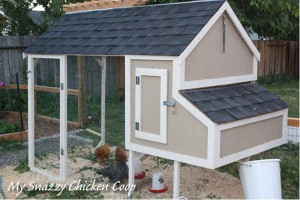The skills needed to build a basic chicken coop are within the abilities of most people. It is not the kind of carpentry that requires an expert finish, although having it end up reasonably square with itself is preferable (unless you are aiming for a Dr Seuss look). With smaller coops you don’t even have to worry about that too much, attempting a larger coop such as a big shed to house 50 or more chickens is where those kinds of things become most important, but a nice little coop is well within the building skills of most people. If you can put up a cupboard, you can probably build a chicken coop.
There are a few considerations though before you jump into it.
- Your time – If your chickens are already ordered and on their way then you may not have time to build a coop. Even a small coop is probably going to need the weekend to build – but then again, if it is that urgent, building may be your only option as ordering a coop would probably be too late (and if you order a flat pack coop you still will have to put it together anyway). If you don’t have much time but want to be involved in designing and building your own coop (or adapting a coop design) then perhaps enrolling a friend who is good at diy or hiring a carpenter to work from your chosen plans would be a good compromise.
- Your abilities – If you can handle a hammer, a saw, a drill, and a paint brush, you can probably build a chicken coop. You will find it much easier if you have done some kind of diy before. If your first ever carpentry project is a chicken coop, you may take to it like a duck to water (it happens) and build a beautiful chicken coop you are proud of and that looks great in the garden, but try to be a bit conservative with your ambitions just in case.
- Your tools – Tools are expensive so you should consider what tools you may need to purchase (or borrow) to supplement any that you may already have. With a lot of the smaller coop designs you will basically be banging together pieces of wood and sticking on small holed galvinised steel wire to a frame for the run (‘chicken wire’ will keep your chickens in but is not strong enough to keep out any serious predators). So apart from cutting the wood to size (and it may be possible to order wood cut to the sizes you want at your store) you would need at the very least a hammer, selection of nails/staples and wire cutters. You should probably have a tape measure, speed square, and a level, too. I have known people build a coop using just a nail gun for the wooden framing and a staple gun to fix the wire to it – it won’t be a big fancy ‘this is better than my house’ type of coop, but still, if it keeps the chickens dry and safe from predators that really is all that matters.
- Your blueprints – You’ll find blueprints so rudimentary that they don’t even give specific lengths and widths, and some so incredibly complex they require an advanced degree in architecture. There are many free coop designs available on the web which can be great for getting ideas from and also may be something you can use to help if you want to come up with your own design (squared graph paper can be helpful for drawing out ideas). There are also plans which can be purchased and are usually around the $10-$30 range for a single plan. The benefit of these is that they usually go into much greater details than the free ones and will also include helpful details such as the measurements and materials lists. A collection of plans like the ones here can also give you ideas and the basis for your own plan, even if you don’t want to follow one exactly – and as you get multiple plans included it can also help you pick and choose bits you like and in the future when you want to upgrade/expand (often your first chicken coop will not be your last!) you will have other coop designs already on hand. Most purchased ones include the materials list and measurements etc. as you might expect but what I particularly like about that collection is that they are real coops that have actually been used – a lot of others I have seen on the web are just cartoon drawings of what it ‘might’ look like. Having said that though if you do like a more cartoony feel to your designs then there is another collection of blueprints you might like to look through here. There aren’t quite as many included, and it is a little bit more expensive, but there are a few extra bonus ebooks on chicken care thrown in which the first collection doesn’t have. Between the two there are more than 15 designs so there is quite a few to choose from.
Keep in mind that you don’t have to buy all your materials brand new. You may be able to find scrap lumber or things like roofing shingles from builders yards, carpentry shops, hardware stores and classified ads. By doing a bit of diy and building your own coop and being a little bit flexible with the design and materials list so you can make use of any free or cheap supplies you can often benefit from quite big savings when compared with a bought coop.


Join the Discussion!